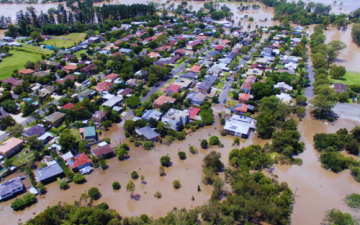Descartes Underwriting’s Head of North America, Daniel Vetter, shares his insights on natural peril evolution and how market circumstances are having a profound impact on the insurance industry. Read on to discover Daniel’s observations on how parametric products are gaining significant traction amidst climate uncertainty while capacity constraints continue to challenge traditional carriers.

What is your perspective on the current market conditions in the US?
Overall, the North American property-casualty market has been improving over the past few years. Most property-casualty insurers and reinsurers have refined their underwriting practices and focus on profitability, and economic performance has been improving significantly. This comes after a prolonged period of underperformance within the sector, where underwriting profitability was mostly non-existent for many years.
The market began to change and adapt around 2016 and 2017. The change introduced several corrective measures on the underwriting side regarding terms and conditions, available capacity and pricing. This is particularly true for many prominent lines of business, such as long-tail liability and Property Nat Cat, which had been underperforming for an extended period.
What are the current capacity constraints across the region?
The insurance industry affects many individual lines, industry sectors, and regions. Starting at a high level, the underperforming ones, such as property nat cat and general and auto liability, have continued to adjust in terms of pricing and available capacity. Also, the insurance industry realized that the historical approach of using experience data to predict future claims trends was largely inadequate and led to subpar underwriting and pricing decisions for many industry sectors and individual accounts.
In addition, climate change has taught us that a rear-view mirror approach is inadequate to appropriately price and underwrite in a rapidly changing environment and uncertain market conditions. As a result, parametric insurance products have gained traction as Underwriters take a different approach to analyzing and pricing natural perils compared to the traditional insurance sector.
I don’t believe that prevailing capacity constraints in the traditional market will change dramatically over the next few years. If we look at the predictions of some of the industry leaders, the hard market is only about to truly start when it comes to natural catastrophe lines. Buyers will continue to be challenged as capacity will continue to be constrained, and pricing will continue to increase. The demand for alternative approaches like parametrics is expected to grow further.
What demand do you see across the country for parametric insurance solutions? Which states or perils are currently at capacity?
Hurricane Ian – with insured losses currently expected to be around $50bn – will put further strain on an already challenged insurance marketplace in Florida. For many insurers, purchasing reinsurance capacity for wind will be extremely difficult from now on. This will have a profound impact on their ability to write business in that State.
Inevitably, this leaves many individuals and companies challenged and uncovered as their exposure increases while the protection offered by their insurance carriers decreases. Consequently, this protection gap has significantly widened over the years as the traditional sector capacity has declined.
We are observing similar trends for perils such as hail, tornado and wildfire. The traditional insurance market has been dramatically curtailing capacity, tightening terms and conditions and increasing pricing, and even some insurers have exited entire risk classes or industry segments.
In contrast, from a social and economic standpoint, more people have been moving into wildfire-prone areas. Housing prices in Los Angeles, Seattle and San Francisco – among the highest in the country – have naturally pushed people into more rural areas of California, Oregon, Washington and Colorado. Unfortunately, these are the same areas that have become hot spots for wildfires over the last few years.
If we want to look at hail, hail events have not increased in frequency or severity. Yet, what’s happening is that population and industry growth has expanded across states like Texas, Oklahoma and Colorado, which are prone to severe convective storm events.
Therefore, what the traditional insurance market has done in the past and continues to do is to retreat from providing coverage for hail and tornadoes. As a result, industries like the solar and renewable energy sectors have been very much challenged to complete specific projects due to a profound lack of available insurance capacity.
There will be a transition for the insurance industry as it manages the inflation surge; how do you think this could look, or what will this transition look like?
Inflation has a profound impact on the insurance sector. During periods of high inflation, insurance companies face rising claims costs and increased operating expenses. Let’s think about claims valuations: if a policy was underwritten and placed 12 months ago, the claim occurred 9 months ago and gets adjusted today, and the ultimate payout of that claim may be substantially higher than the original assumptions made during the underwriting process. Then you add supply chain challenges (post-Covid), which have increased costs for goods and services even further.
As mentioned, the premiums the insurers have collected may be insufficient to cover the claims that will continue to occur. Therefore, insurers and reinsurers will adjust their pricing methodology, or, if they can’t get enough premium, they may simply take the product off the table. I believe the inflationary environment will give the sector a severe headache in the near future when it comes to valuation of claims; on the other hand, a rising interest rate environment can have a positive impact on reserves – in regards to investment returns – in particular for longer tail lines, such Worker’s compensation or Life Insurance.
One of the critical features we continue to highlight in our discussions with clients and brokers is that parametric insurance is a more efficient product from a corporate finance standpoint. It offers more flexibility than the traditional insurance product and removes the delays typically associated with a traditional claims settlement process, which can be both time-consuming and frustrating. A parametric risk product offers clients the opportunity to swiftly collect – and deploy – claims proceeds shortly after a triggering event has occurred.
Do you think there is a hesitancy in embracing parametric insurance amongst corporates? What are some of the challenges that you are seeing?
Normalizing the concept is one of our main challenges. It’s not a ‘property all risk cover’, which is part of discussions we’re having with brokers and clients. Once people have ‘consumed the kool-aid,’ so to speak, parametric insurance becomes a more straightforward insurance product than what the traditional market is offering. Most people we talk to have spent years purchasing traditional insurance. This includes the typical frustrations of coverage limitations, fluctuations in pricing and a constant adjustment of underwriting appetite on the part of their traditional insurance partners.
However, adopting a new concept, such as parametric risk insurance, takes time. When we talk to risk managers, we are mindful that they may not be the only decision-maker within their company. That is probably why the adoption rate is lower than the parametric product offering warrants.
Articulating what we do and how the product applies is essential when creating awareness of parametric insurance concepts. As mentioned, the product is much more straightforward than any traditional insurance product.

Have you encountered anything interesting related to market trends?
The parametric insurance market is a growing marketplace. If you compare parametric insurance today vs. what it was ten years ago, it has changed drastically. Regarding who is interested and who the product could apply to, from a single location condominium association in Miami Beach to a multi-location global corporation and anywhere in between. What’s more, the applicability of the product has become more prominent and relevant for insurers.
Where do you see the parametric market going in the future? Do you think it will become more of a replacement product?
I see a lot of runway for what we do within the industry. I wouldn’t say the opportunities are endless, but they will continue to develop over the next few years. The frustrations relative to traditional insurance will not ease, the claims settlement process will not get any shorter, and insurance companies are spending more time improving their service capabilities. Natural catastrophe claims will continue to be large and complex and will take time to adjust.
I believe people will continue increasingly using parametric products to replace, complement or supplement traditional insurance. For some, parametric coverage will become a replacement, but the prominence of our product will continue to rise and undoubtedly ease capacity constraints, and pricing challenges companies are facing.
As organizations continue to evolve, particularly in the current economic environment, corporations and organizations will continue to focus on the total cost of risk – and associated capital costs. From a corporate finance perspective, switching to parametric insurance is an absolute no-brainer.



